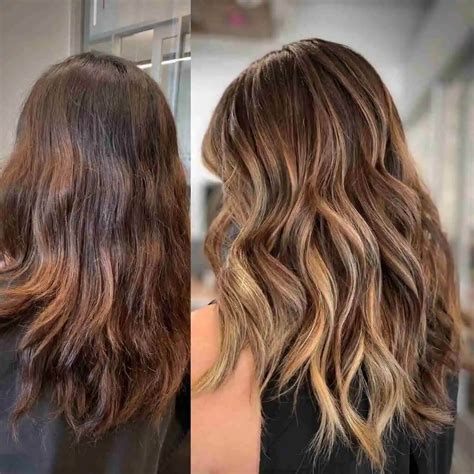Balayage Partial vs Full: A Comprehensive Comparison to Enhance Your Hair

Introduction
Balayage, a French hair coloring technique, has gained immense popularity for its ability to create natural-looking highlights with seamless transitions. However, understanding the distinction between partial and full balayage is crucial to achieve your desired hair transformation. This article provides an in-depth comparison of both techniques, empowering you to make an informed decision.
Partial Balayage
Partial balayage involves strategically placing highlights on specific sections of your hair, typically around the face and crown. This technique aims to enhance your hair’s natural depth and dimension without drastically altering its overall color.
Benefits of Partial Balayage
- Subtle and Natural: Creates subtle highlights that blend seamlessly with your base color.
- Focal Emphasis: Frames the face and highlights desired features.
- Low Maintenance: Requires less touch-ups since the base color remains largely intact.
- Suitable for All Hair Types: Works well on various hair textures, including fine, medium, and coarse.
Drawbacks of Partial Balayage
- Limited Color Transformation: Highlights are confined to specific areas, resulting in a less dramatic color change.
- Can Be Time-Consuming: Placement of the highlights requires precision, which can extend the application time.
Full Balayage
Full balayage involves distributing highlights throughout the entire head of hair. This technique creates a more noticeable color shift, transitioning from dark roots to lighter ends.
Benefits of Full Balayage
- Dramatic Color Change: Creates a striking transformation by significantly lightening the hair.
- Creates Dimension: Adds depth and volume to the hair, making it appear fuller.
- Trendy and Fashionable: Embraces current hair coloring trends that emphasize a sun-kissed look.
- Suitable for Most Hair Colors: Works well on light, dark, and even color-treated hair.
Drawbacks of Full Balayage
- High Maintenance: Requires regular touch-ups to maintain the highlights’ vibrancy.
- Can Be Drying: The bleaching process involved in full balayage can dry out hair, especially if not properly cared for.
- Not Ideal for Short Hair: May overwhelm shorter hair lengths, making it difficult to achieve a natural blend.
Which Technique Is Right for You?
The choice between partial and full balayage depends on your desired hair transformation and personal preferences.
- Partial balayage: Ideal for subtle enhancements, framing the face, or adding dimension to your hair.
- Full balayage: Suitable for a more dramatic color change, creating depth, and achieving a sun-kissed effect.
Comparative Table
| Feature | Partial Balayage | Full Balayage |
|---|---|---|
| Highlight Placement | Specific sections | Throughout the hair |
| Color Transformation | Subtle | Dramatic |
| Maintenance Level | Low | High |
| Suitability | All hair types | Most hair colors |
| Time Consumption | Longer | Shorter |
Effective Strategies for Natural-Looking Balayage
- Use Multiple Shades: Combine different shades of the same color to create a more natural blend.
- Consider Your Skin Tone: Choose highlight shades that complement your skin undertones.
- Foil or No Foil: Foils can help create stronger contrast, while freehand application produces softer transitions.
- Professional Application: Consult a skilled hairstylist to ensure precise placement and optimal results.
Common Mistakes to Avoid
- Over-Bleaching: Be mindful of bleach application time to prevent hair damage.
- Incorrect Sectioning: Precise sectioning is essential for even distribution of highlights.
- Poor Blending: Ensure smooth transitions between highlights and base color.
- DIY Attempts: Attempting balayage at home without proper training can lead to uneven results.
Step-by-Step Approach to Balayage
- Section and Pre-Lighten: Divide the hair into sections and pre-lighten the desired areas.
- Hand Paint: Apply the bleach or color to selected strands using a brush or comb.
- Wrap or Foil: Wrap highlighted strands in foils to enhance the lightening process (optional).
- Process and Rinse: Allow the bleach to process according to the manufacturer’s instructions and rinse thoroughly.
- Tone and Condition: Apply a toner to neutralize any brassiness and condition the hair to restore moisture.
Innovative Applications of Balayage
- Oil Balayage: Uses oil-based bleach to create a softer, less damaging highlight.
- Reverse Balayage: Darker roots are blended into lighter ends to create a subtle ombré effect.
- Strobing Balayage: Highlights are strategically placed in areas where light naturally hits the hair, creating a 3D illusion.
Conclusion
Partial and full balayage offer distinct benefits and drawbacks. Whether you seek subtle enhancements or a dramatic color change, understanding the differences between these techniques empowers you to make an informed decision. Embracing effective strategies, avoiding common mistakes, and following a professional approach can elevate your balayage results, leaving you with a stunning, trendsetting hair transformation. Remember to consult a skilled hairstylist for optimal outcomes and hair health maintenance.
